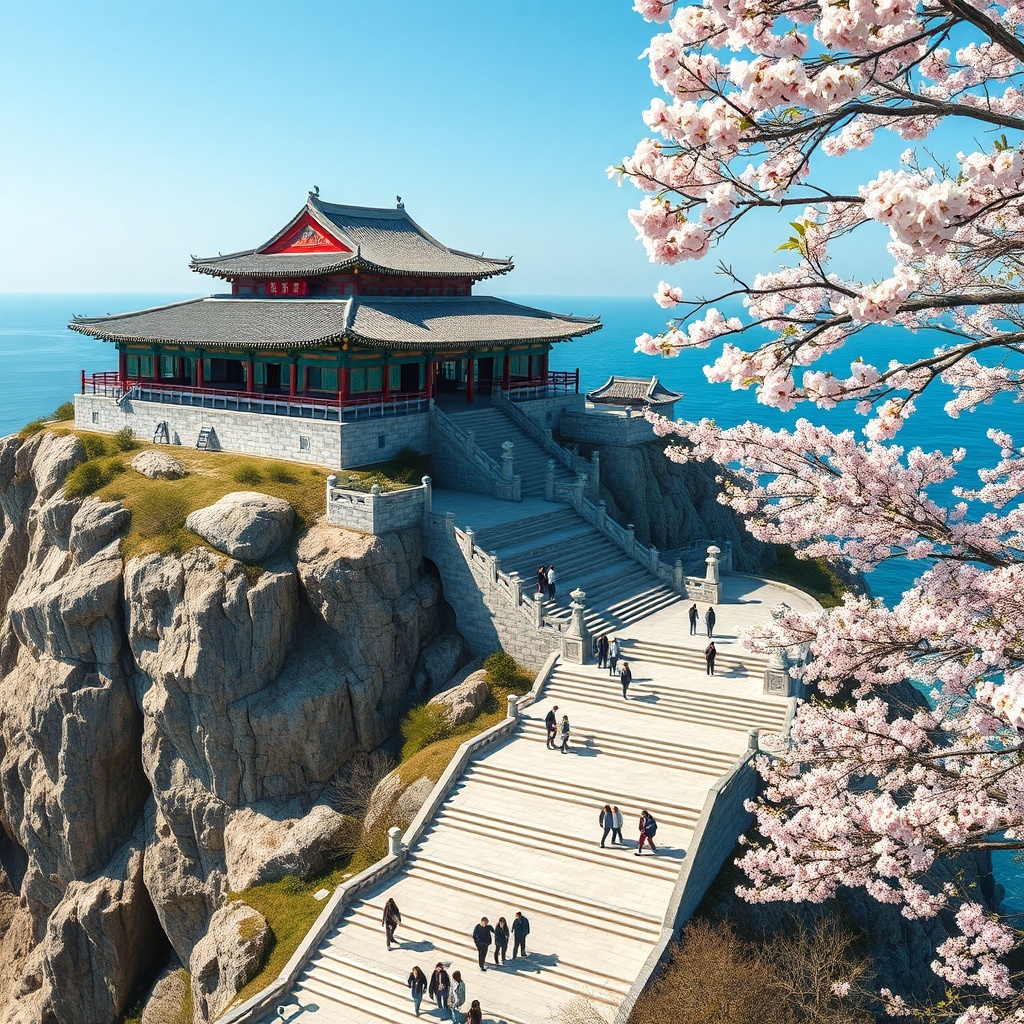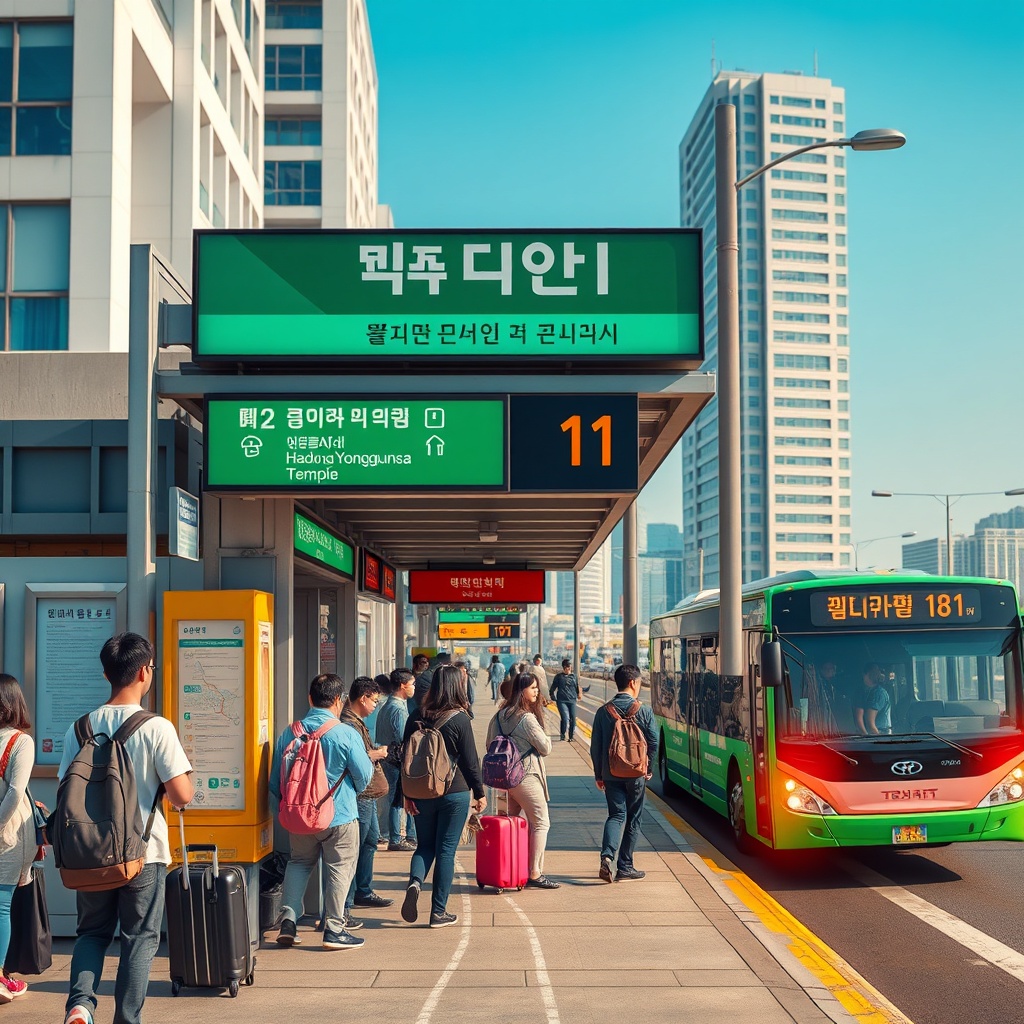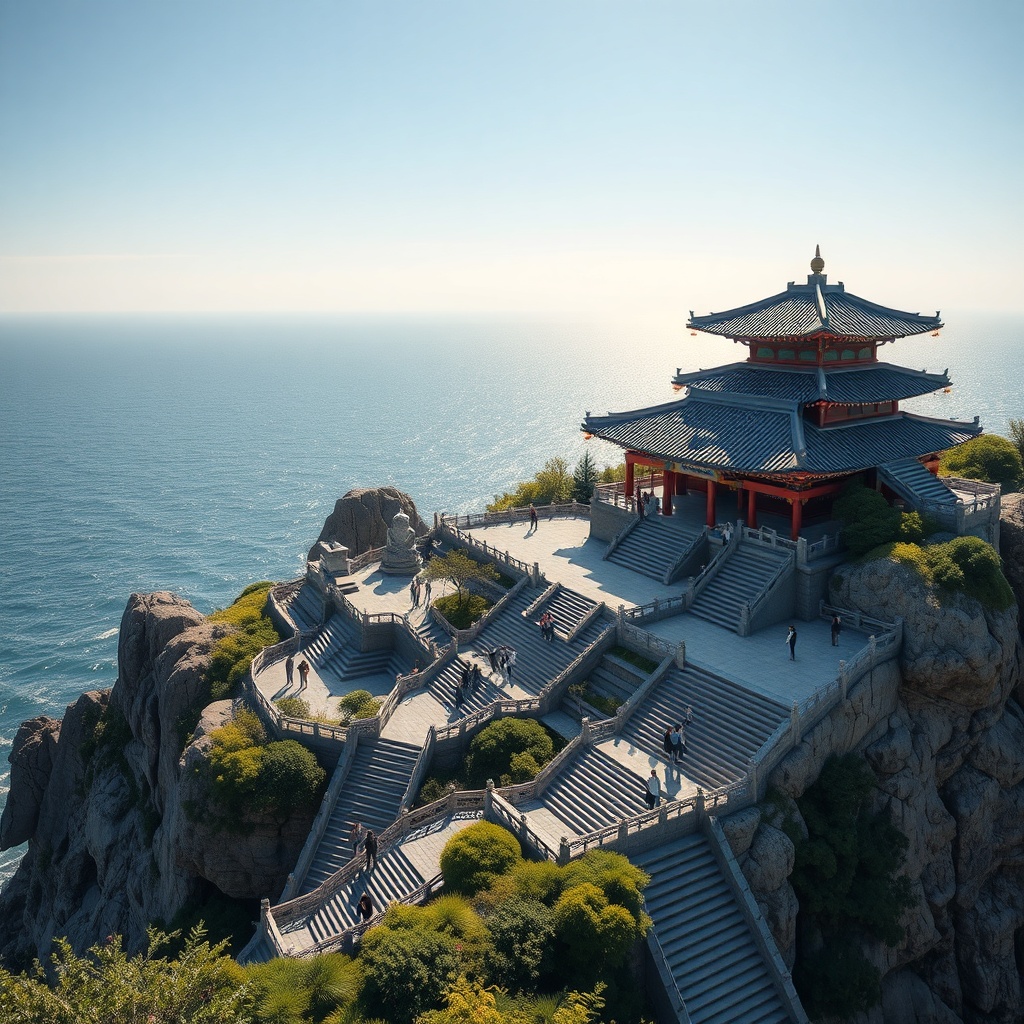Explore Haedong Yonggungsa Temple - A Coastal Gem
Welcome to the Enchanting Shores of Haedong Yonggungsa Temple
Are you ready to experience one of Korea’s most extraordinary treasures? Haedong Yonggungsa Temple isn’t just a historic Buddhist sanctuary — it’s a masterpiece perched on dramatic seaside cliffs, with sweeping views of the East Sea and a soul-stirring blend of spirituality and scenic beauty.
If you crave a blend of history, culture, and coastal adventure, keep reading! This guide unveils the wonders of Haedong Yonggungsa step by step — from how to get there by public transport, to what you can see, do, and taste, all with elegantly designed font and vibrant colors to spark your travel imagination. Whether you’re a solo explorer, a family seeking peace, or a culture lover, this journey promises lasting memories. Dive in and discover why Haedong Yonggungsa Temple truly is a ‘Coastal Gem’!

Haedong Yonggungsa Temple is one of Korea's most unique Buddhist temples, perched dramatically on the rocky northeastern coast of Busan. Unlike most temples, which are nestled in the mountains, this coastal gem offers breathtaking ocean views and a spiritual atmosphere that blends nature and tradition.
Let's explore the fascinating history of Haedong Yonggungsa, practical information about admission, and essential tips for parking—so you can make the most of your visit.
Founded in 1376 during the Goryeo Dynasty by the great Buddhist teacher Naong Hyegeun, Haedong Yonggungsa has a history that stretches back over 600 years. According to legend, the temple was built after Naong had a vision of the Sea God (Yongwang) who instructed him to establish a temple by the sea to bring peace and prosperity to the people.
This origin story is reflected in the temple's name: "Haedong" means "East Sea" and "Yonggungsa" translates to "Palace of the Dragon King." Today, visitors can still feel the mystical energy that has drawn pilgrims and travelers for centuries.
Insight: Visiting Haedong Yonggungsa isn't just about sightseeing—it's about connecting with Korea's spiritual heritage and appreciating the harmony between human creation and the natural world.
One of the best things about Haedong Yonggungsa is that admission is free for all visitors. This makes it an accessible destination for families, solo travelers, and those seeking a meaningful experience without breaking the bank.
The temple is open year-round, but hours may vary depending on the season. It's recommended to visit early in the morning or on weekdays to avoid crowds, especially during cherry blossom season or Buddha's Birthday, when the temple is adorned with colorful lanterns.
- Opening Hours: Usually from sunrise to sunset
- Best Time to Visit: Spring (cherry blossoms) and May (Buddha's Birthday festival)
Tip: While admission is free, donations are welcome and help with temple maintenance and community services.
Parking at Haedong Yonggungsa is convenient but can be challenging during peak times. There are several public parking lots near the temple entrance, with a short walk (about 10 minutes) along a scenic path to the main gate.
| Parking Lot | Distance to Temple | Fee |
|---|---|---|
| Main Public Lot | 600m (10 min walk) | 2,000-4,000 KRW (varies by vehicle size) |
| Overflow Lot | 800m (15 min walk) | Free or small fee (seasonal) |
During weekends and holidays, parking fills up quickly. Arriving early or using public transportation (such as the local bus or taxi) can save you time and stress.
Keywords: Haedong Yonggungsa Temple, history, admission, parking, Busan travel
Haedong Yonggungsa Temple is more than just a tourist spot—it's a place where history, spirituality, and the beauty of Korea's coastline come together. By understanding its background, knowing the practical details, and planning your visit, you can create a memorable and enriching experience that goes beyond the ordinary.
Whether you're a history buff, a spiritual seeker, or simply someone who loves scenic views, this coastal temple is sure to leave a lasting impression.

Haedong Yonggungsa Temple is one of Busan's most iconic destinations, famous for its stunning seaside location and spiritual ambiance. But before you can immerse yourself in its beauty, you need to know how to get there efficiently—especially if you’re relying on public transport. Let’s walk through the best ways to reach this coastal gem, so you can plan your trip with confidence and ease.
Step 1: Getting to Busan
If you’re not already in Busan, start by taking a KTX or express bus from Seoul or other major cities. Busan Station is a central hub, making onward travel straightforward.
Step 2: Subway to Haeundae Station
From Busan Station, hop on the Busan Metro Line 2 and ride to Haeundae Station (Exit 7). This is a popular area, so you’ll find plenty of signs and helpful locals. Haeundae is also a great place to grab a snack or coffee before heading to the temple.
Step 3: Bus to Yonggungsa Temple
At Haeundae Station, take Bus 181 towards the temple. The bus stop is just outside Exit 7. The ride takes about 35-40 minutes, winding along Busan’s scenic coastline. Stay alert for the stop called Yonggungsa Temple (용궁사). Don’t worry—the bus usually announces major stops in English and Korean.
- Bus 181 Schedule: Runs every 15-20 minutes from early morning (around 5:30 AM) to late evening (around 10:30 PM).
- Fare: Approx. 1,400 KRW (with T-money or cash).
Step 4: Short Walk to the Temple
Once you get off at the Yonggungsa stop, follow the signs for a 10-minute walk down a gentle slope. The path is lined with souvenir shops and food stalls, adding to the anticipation. Soon, you’ll hear the sound of waves and see the temple’s dramatic silhouette against the sea.
Tips for a Smooth Journey
- Travel Early: Haedong Yonggungsa is very popular, especially on weekends and holidays. Arriving early helps you avoid crowds and enjoy a peaceful visit.
- Check Bus Schedules: While Bus 181 is frequent, it can get crowded during peak hours. Consider using a real-time bus app like KakaoMap or Naver Map for live updates.
- Prepare for Weather: The coastal path can be windy or rainy. Bring a light jacket or umbrella, especially in spring and autumn.
- Accessibility: The walk from the bus stop to the temple is paved but includes some stairs. Wear comfortable shoes.
| Transport | Route | Estimated Time | Notes |
|---|---|---|---|
| Subway | Busan Station → Haeundae Station (Line 2) | 45 min | Frequent trains, easy transfers |
| Bus | Haeundae Station (Exit 7) → Yonggungsa Temple (Bus 181) | 35-40 min | Beautiful coastal views |
| Walk | Bus stop → Temple entrance | 10 min | Shops and food stalls along the way |
Reaching Haedong Yonggungsa Temple by public transport is not only affordable and eco-friendly, but also a chance to experience local life in Busan. With a little planning, your journey will be smooth and memorable. Enjoy the adventure—and don’t forget your camera!

Haedong Yonggungsa Temple is not just a religious site; it's a vibrant tapestry of history, spirituality, and breathtaking coastal scenery. If you are planning a visit, knowing the must-see spots will help you make the most of your journey and truly experience the temple's unique charm.
Let’s embark on this exploration using the classic 8-stage storytelling formula, guiding you through each essential location as if you’re on a hero’s journey—starting from curiosity, through discovery, to transformation.
- The Entrance and 108 Steps
Your adventure begins at the grand entrance, where you are greeted by the majestic stone gate. Descending the 108 steps—symbolizing the 108 earthly desires in Buddhism—offers a mindful start. Pause to enjoy the ocean breeze and let each step be a moment of reflection. - Haesu Gwaneum Daebul (Seawater Great Goddess Buddha)
At the base, you’ll find the impressive statue of the Seawater Great Goddess Buddha, facing the sea. This is a place for wishes and prayers, and many visitors leave tokens of hope here. It’s a reminder to focus on your intentions and aspirations. - Main Sanctuary (Daeungjeon)
The heart of the temple, Daeungjeon, is where rituals and meditation take place. The intricate architecture and colorful lanterns create a serene atmosphere. Take a moment to sit quietly and absorb the spiritual energy—this is the transformation stage of your journey. - Pagoda with Four Lions
Nearby stands a unique pagoda, guarded by four lions representing joy, anger, sadness, and happiness. This spot encourages self-reflection: which emotion do you carry today? It’s a beautiful place for photos and introspection. - Statue of the Laughing Buddha
As you wander, you’ll meet the Laughing Buddha, a symbol of happiness and abundance. Rubbing his belly is said to bring good luck—don’t miss this cheerful ritual! - Coastal Viewpoints
One of the temple’s most stunning features is its location right on the rocky coastline. Several viewpoints offer panoramic vistas of the sea, the temple buildings, and the horizon. These spots are perfect for mindful breathing and gratitude. - Wishing Pond and Bridge
Toss a coin into the wishing pond or cross the picturesque bridge for a moment of hope and renewal. This is where you symbolically return from your journey, carrying new insights and intentions. - Gift Shops and Local Stalls
Before you leave, explore the small shops selling Buddhist charms, local snacks, and souvenirs. Supporting these vendors is a way to give back and complete your journey with a sense of community.
Tips for Your Visit:
- Arrive early to avoid crowds and enjoy the tranquil morning light.
- Wear comfortable shoes for the steps and uneven paths.
- Bring a camera—the views are unforgettable!
Visiting Haedong Yonggungsa is more than sightseeing—it’s a journey of self-discovery, reflection, and connection with nature. Each spot has its own story, and together they create an experience that can inspire gratitude and inner peace.
Whether you’re seeking spiritual insight, cultural enrichment, or simply a beautiful day by the sea, these must-see spots at Haedong Yonggungsa will leave a lasting impression on your heart and mind.

Visiting Haedong Yonggungsa Temple is more than just a sightseeing stop—it's an opportunity to immerse yourself in local culture, spirituality, and breathtaking coastal scenery. To truly make the most of your visit, a few local tips can transform your experience from ordinary to unforgettable.
1. Arrive Early for Tranquility
The temple is a popular destination, especially during weekends and holidays. Arriving before 9 a.m. lets you enjoy the serene ambiance, hear the sound of waves, and take unobstructed photos of the temple's stunning architecture and ocean backdrop. Early mornings are also perfect for quiet reflection or meditation, connecting you to the spiritual essence of the place.
2. Dress Respectfully and Comfortably
As a sacred Buddhist site, modest attire is appreciated. Wear comfortable shoes—there are stone steps and coastal paths to explore. If you plan to participate in any temple rituals, long pants and covered shoulders are recommended. Respecting local customs not only shows cultural sensitivity but also deepens your sense of connection to the site.
3. Explore Beyond the Main Halls
While the main temple buildings and the iconic golden Buddha statue draw most visitors, don't miss the smaller shrines, hidden pagodas, and scenic viewpoints along the cliffs. Locals often recommend following the coastal path to discover quiet spots for contemplation and photography. This is where you can truly appreciate the temple's harmony with nature and the sea.
4. Try the Local Street Food
Just outside the temple entrance, you'll find a bustling row of food stalls selling fresh seafood, sweet rice cakes, and traditional snacks. Sampling these treats is a delicious way to experience local flavors and support the community. Don't miss the hotteok (sweet pancakes) or grilled squid, both favorites among regular visitors.
5. Participate in a Temple Stay or Ritual
If your schedule allows, consider joining a temple stay program or participating in a Buddhist ceremony. These experiences offer rare insight into Korean Buddhist traditions, mindfulness practices, and the daily life of monks. Even a short meditation session or lighting an incense stick can make your visit more meaningful.
| Tip | Benefit |
|---|---|
| Arrive Early | Peaceful atmosphere, better photos |
| Dress Modestly | Respect local customs, access to rituals |
| Explore Side Paths | Discover hidden views, quiet spots |
| Try Local Food | Authentic flavors, support locals |
| Join a Ritual | Deeper cultural and spiritual insight |
Bonus: Photography Tips ▼
For the best lighting, shoot during golden hour (shortly after sunrise or before sunset). Wide-angle lenses capture the temple and ocean together, while telephoto shots highlight intricate statues and details. Respect signs about restricted photography, especially inside prayer halls.
By following these local tips, you’ll not only enrich your own journey but also foster respect for the sacred site and its community. Whether you’re a first-time visitor or a returning traveler, Haedong Yonggungsa Temple offers endless opportunities for discovery, reflection, and inspiration.
- Arrive early for peace and the best views.
- Dress appropriately to honor local traditions.
- Wander off the main path for hidden gems.
- Enjoy street food for a taste of Busan.
- Participate in a ritual for deeper meaning.
Let these tips guide you to a richer, more mindful temple experience on Korea’s stunning coast.
